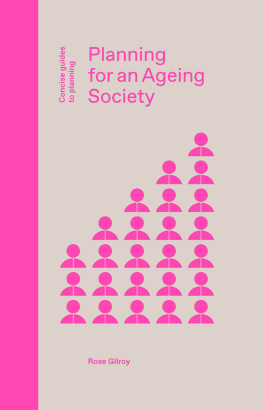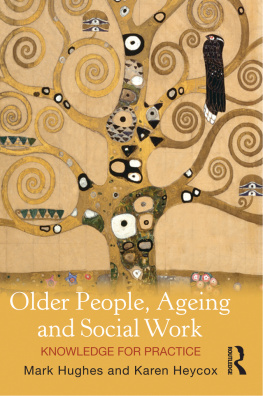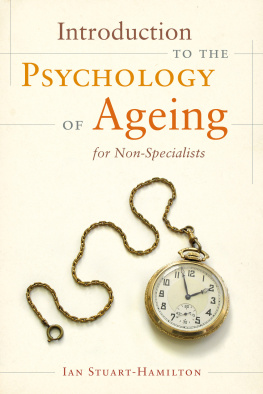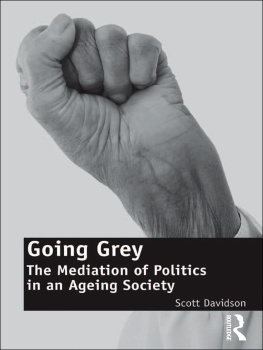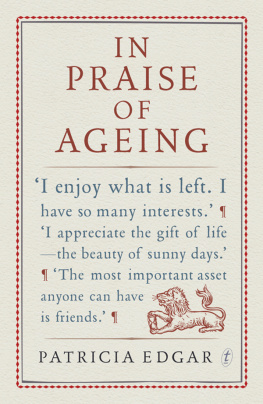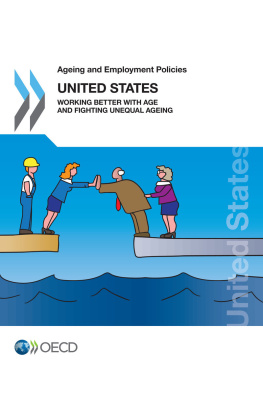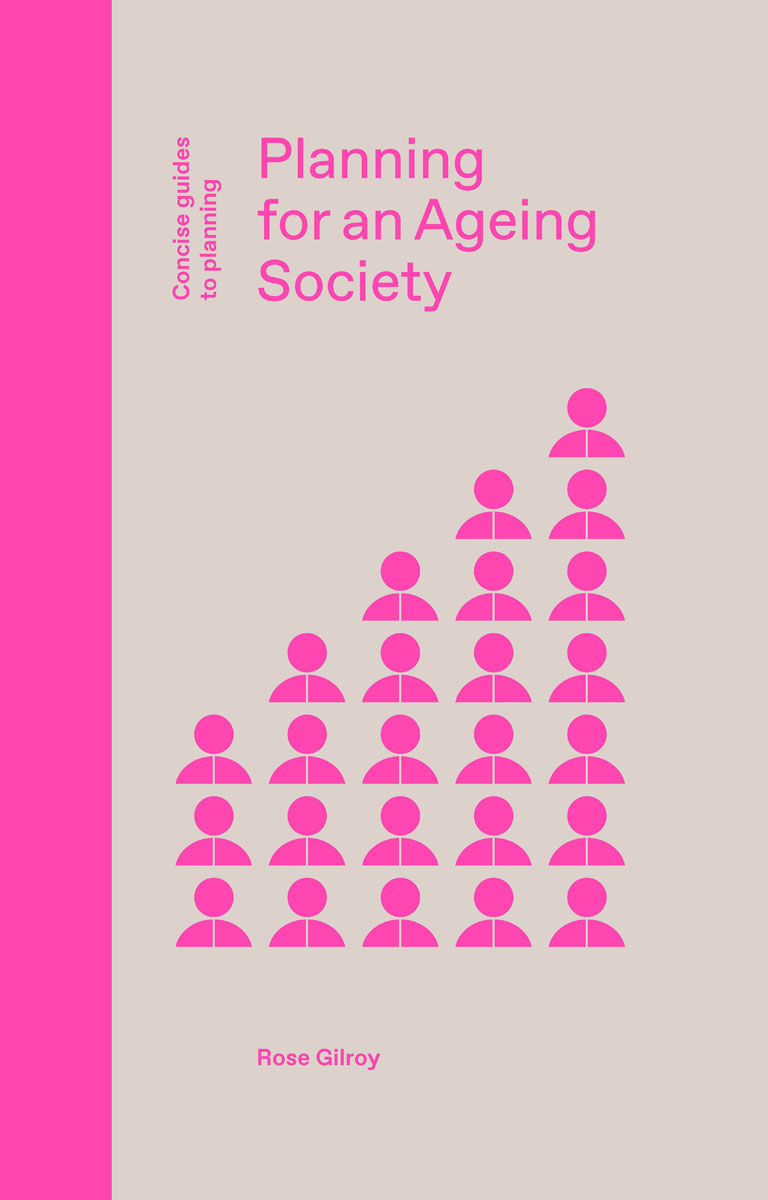
First published in 2021 by Lund Humphries
Lund Humphries
Office 3, Book House
261A City Road
London EC1V 1JX
UK
www.lundhumphries.com
Planning for an Ageing Society Rose Gilroy, 2021
All rights reserved
ISBN (hardback): 9781848223448
ISBN (eBook PDF): 9781848223639
ISBN (eBook ePub): 9781848223646
ISBN (eBook Mobi): 9781848223653
Concise Guides to Planning (Print): ISSN 25168177
Concise Guides to Planning (Online): ISSN 25168185
A Cataloguing-in-Publication record for this book is available from the British Library.
All rights reserved. No part of this publication may be reproduced, stored in a retrieval system or transmitted in any form or by any means, electrical, mechanical or otherwise, without first seeking the permission of the copyright owners and publishers. Every effort has been made to seek permission to reproduce the images in this book. Any omissions are entirely unintentional, and details should be addressed to the publishers.
Rose Gilroy has asserted her right under the Copyright, Designs and Patent Act, 1988, to be identified as the Author of this Work.
Cover design by Stefi Orazi
Copy edited by Pamela Bertram
Typeset by Jacqui Cornish
Proofread by Patrick Cole
Set in Favorit
Printed in the United Kingdom
Image credits:
All figures and tables are from the authors own sources, with the exception of : adapted from Foresight, Government Office for Science (2019).
Contents
Chapter 1
Living in an Ageing Society
Chapter 2
Quality of Place
Chapter 3
Age-Friendly Communities
Chapter 4
Listening
Chapter 5
Housing
Chapter 6
Mobility
Chapter 7
Planning for Our Own Tomorrow
Foreword
We need a fundamental rethink of how we plan for the needs and aspirations of ageing societies. For too long, planners, developers, and politicians have neglected the potential for good planning to improve the quality of life of older people and support their ability to live in homes and places of their own choosing, living productive and fulfilling lives. Adequate provision appears to have been the aspiration for too many, for too long, when it comes to catering for the needs of our ageing societies, rather than creating wonderful, vibrant, and inspiring places to live. We can and must do better.
Planning for an Ageing Society is an invaluable resource for those wanting to know more, drawing on the best of recent scholarship in this area and illustrated with a wide range of inspiring examples from practice. This is a topic of such fundamental importance to us all that this book should be compulsory for all planners, developers, and students of planning. As the text illustrates, this is a fast-evolving policy field with which planners need to engage fully, rather than relegating it to the status of too hard or someone elses problem. Rose Gilroys book should inspire us to do more to create the kinds of places where we would be happy for ourselves and everyone else to live, as we grow older.
Graham Haughton, Series Editor
Acknowledgements
I am grateful to Ryder Architects for permission to use an image from the Future Homes Development. Thanks to Dominic Langton, Damien Wootten, and Older Womens Cohousing for permission to use their photographs.
Many thanks to Ben Spencer for circulating my request for information on more enlightened cycling practice and to Tim Jones, Alison Kennedy, and Don Naylor for generously responding.
Grateful thanks to those who responded to the invitation to rethink the future: Barbara Douglas, Alan Gowers, Dominic Langton, Amy Murray, Anne Murray, Anne Raffle, Moyra Riseborough, Esther Salamon, Ian Shergold, Ben Spencer. Thanks to Charles Musselwhite for circulating my invitation around his Welsh networks.
Chapter 1
Living in an Ageing Society
This book is about you and about me.
Demographic trends suggest that most of us will grow old. However, that later life will be highly diverse as, with all life stages, it is mediated by class, wealth, social capital, marital status, household composition, care roles, gender, ethnicity, sexuality, and disability.
Despite the clear demographic picture, there is no national strategy on ageing for the UK or for any of the devolved administrations. While ageing is often cited as a grand societal challenge and figures in the UKs industrial strategy, it is not ageing, the lifelong process, but old age that is the political concern (Walker, 2018). A focus on ageing would lead to a strategy that discussed maternal health, the importance of good nutrition throughout life, as well as investment in education from nursery through to lifelong learning and ability to retrain as employment opportunities or personal circumstances alter, would ensure that everyone had lifelong access to decent housing, an income that allowed people to live with dignity, and opportunities for community involvement and new activities, as well as end-of-life care and a discussion of euthanasia.
If the emphasis is the life-course, then do planners need to think specifically about later life? Ageing is not a disease to be cured, nor is the ageing population a problem to be solved. However, age is a factor that changes how people relate to the world around them. The extent to which our environments continue to offer opportunities for living a good quality of life as our needs change is critical to our wellbeing and sense of self. This book argues for creating places that might support people to grow into old age, to care for themselves as well as for their relatives, friends, and neighbours. In a time of demographic change there is a need to develop policies and practices that enable us to adapt to this societal challenge. How can our housing, transport, public realm, and social infrastructure respond?
Given the evidence to support the impact of the environment on later lives, there is no overarching planning strategy. The current National Planning Policy Framework promotes living in healthy communities that demonstrate thoughtful design principles, with sustainable transport options and shopping and social opportunities that work for everyone. Mentions of older people, however, are few and confined to the section on the supply of housing (Ministry of Housing, Communities and Local Government, 2019a). Within the Planning Practice Guidance (PPG), there is more thoughtful discussion, but the focus is narrow.
In striving to make a place more age friendly it remains the case that there is only one city, one town, one village. Every place needs to respond to the child, the young person, families, and older people.

Ageing of the UK regions and the implications
While the UKs population is ageing in line with most nations in the world, the picture across the regions is very varied. At the extremes are London and the South West of England.
Nine of the ten UK areas with the lowest proportion of those over 65 are London boroughs. Similarly, London also has eight of the nine areas with the lowest proportion of those over 85. Less than one per cent of Tower Hamlets residents are 85 or older. Alone among the English regions, London is a place of younger working age adults (Office of National Statistics, 2020a).
Next page
